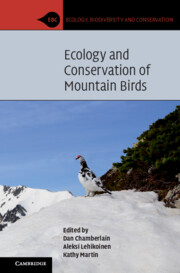Book contents
- Ecology and Conservation of Mountain Birds
- Ecology, Biodiversity and Conservation
- Ecology and Conservation of Mountain Birds
- Copyright page
- Contents
- Contributors
- Preface
- Acknowledgements
- 1 Mountain Birds and Their Habitats
- 2 Avian Adaptations to High Mountain Habitats
- 3 Global Bird Communities of Alpine and Nival Habitats
- 4 Birds of Treeline Ecotones
- 5 Population Trends of Mountain Birds in Europe and North America
- 6 Climate Change Impacts on Mountain Birds
- 7 Anthropogenic Activities and Mountain Birds
- 8 Modelling Large-Scale Patterns in Mountain Bird Diversity and Distributions
- 9 The Alpine Avifauna of Tropical Mountains
- 10 Priorities for Information, Research and Conservation of Birds in High Mountains
- Bird Species Index
- Subject Index
- Plate Section (PDF Only)
- References
8 - Modelling Large-Scale Patterns in Mountain Bird Diversity and Distributions
Published online by Cambridge University Press: 30 June 2023
- Ecology and Conservation of Mountain Birds
- Ecology, Biodiversity and Conservation
- Ecology and Conservation of Mountain Birds
- Copyright page
- Contents
- Contributors
- Preface
- Acknowledgements
- 1 Mountain Birds and Their Habitats
- 2 Avian Adaptations to High Mountain Habitats
- 3 Global Bird Communities of Alpine and Nival Habitats
- 4 Birds of Treeline Ecotones
- 5 Population Trends of Mountain Birds in Europe and North America
- 6 Climate Change Impacts on Mountain Birds
- 7 Anthropogenic Activities and Mountain Birds
- 8 Modelling Large-Scale Patterns in Mountain Bird Diversity and Distributions
- 9 The Alpine Avifauna of Tropical Mountains
- 10 Priorities for Information, Research and Conservation of Birds in High Mountains
- Bird Species Index
- Subject Index
- Plate Section (PDF Only)
- References
Summary
Modelling distributions of species and communities is a key task for modern ecological research and conservation planning. Modelling mountain birds has specific challenges: mountain environments are characterized by steep gradients, where conditions in terms of climate, topography and habitat change markedly over relatively small scales. Moreover, mountain bird species are often less comprehensively monitored than lowland species, resulting in a general paucity of information for many species. We review the approaches to deal with these challenges in order to increase model accuracy to enhance ecological research and to improve conservation planning in mountain environments. We discuss how consistency between species occurrence and climate is tested, and what approaches help to assess distribution dynamics. We assess the current strategies to model microclimate and microhabitat, and how they could be incorporated in distribution modelling over increasingly larger extents. We discuss the pros and cons of (and the potential options for) modelling multiple species vs. community traits to get broad scale multi-species projections which are useful to evaluate the general persistence and resilience of mountain bird communities. Finally, the opportunities presented by Citizen Science data to contribute to monitoring and modelling mountain bird populations are assessed.
Keywords
Information
- Type
- Chapter
- Information
- Ecology and Conservation of Mountain Birds , pp. 296 - 335Publisher: Cambridge University PressPrint publication year: 2023
References
Accessibility standard: Unknown
Why this information is here
This section outlines the accessibility features of this content - including support for screen readers, full keyboard navigation and high-contrast display options. This may not be relevant for you.Accessibility Information
- 2
- Cited by
